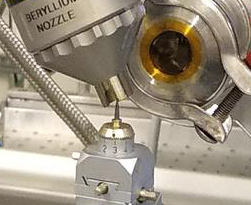Experimental setup at the PETRA III beamline P21.1 (Credit: DESY).
A new study, published in Nature Nanotechnology, has uncovered insights into the structures that could take solar energy to the next level. Researchers working at DESY have found that dynamic nanodomains within lead halide perovskites – materials at the forefront of solar cell innovation – hold a key to boosting their efficiency and stability. The findings reveal the nature of these microscopic structures, and how they impact the way electrons are energised from the light and transported through the material, offering insights to more efficient solar cells.
The study was led by Milos Dubajic and Sam Stranks from the University of Cambridge, in collaboration with an international network, with key contributions from Imperial College London, UNSW Sydney, Colorado State University, ANSTO Sydney, and DESY as well as the Australian Synchrotron and the Diamond Light Source in the UK. Their research shows that by understanding the behaviour of these nanodomains, engineers could fine-tune the properties of perovskites to improve the performance and longevity of solar cells. Until now, the fluctuating nature of these nanodomains had not been fully understood, but this study suggests that mastering their behaviour could enable perovskites to reach their full potential.
“By understanding the dynamic nature of these nanodomains, we can potentially control their behaviour to improve the performance of solar cells and other optoelectronic devices,” says Dubajic. “This could help push the boundaries of energy conversion efficiency.”
One piece of the puzzle in this work is a detailed insight into the atomic arrangement of the nanomaterials, which the PETRA III beamline P21.1 helped to achieve. “Our instrument is particularly powerful for analysing nanostructures”, says Martin von Zimmermann, scientist in charge at P21.1 at DESY and co-author of the article. “We provide high-energy X-rays and large single-photon counting detectors. Such are the optimum state-of-the-art conditions to precisely map out the local atomic structure and disorder by the so-called 3D-ΔPDF representation.” This powerful method has emerged over the past decade exploiting the newest technological advances. Von Zimmermann adds: “ The 'Three-Dimensional Difference Pair Distribution Function' (3D-ΔPDF) is a game changer for assessing complex nanoscale phenomena like in these lead halide perovskites.”
“This research brings us closer to understanding the intricate nanoscale of these materials,” adds Stranks, who is a professor at Cambridge. “By unlocking the secrets of dynamic nanodomains, we can help accelerate the development of perovskite-based solar technologies and make them a more viable solution for the global push towards renewable energy.”
The study builds on the group’s wider work in developing more efficient and sustainable energy solutions through material science. By advancing understanding of materials like lead halide perovskites, the team aims to address global challenges in renewable energy sources like solar power.
(Partly from DESY News)
Reference:
M. Dubajic et al., "Dynamic nanodomains dictate macroscopic properties in lead halide perovskites", Nature Nanotechnology (2025), DOI:10.1038/s41565-025-01917-0







